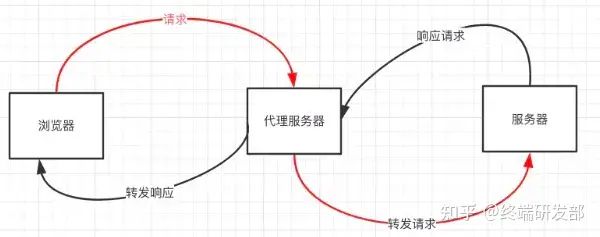九种跨域方式实现原理(完整版)
前言
前后端数据交互经常会碰到请求跨域,什么是跨域,以及有哪几种跨域方式,这是本文要探讨的内容。
一、什么是跨域?
1.什么是同源策略及其限制内容?
同源策略是一种约定,它是浏览器最核心也最基本的安全功能,如果缺少了同源策略,浏览器很容易受到XSS、CSRF等攻击。所谓同源是指"协议+域名+端口"三者相同,即便两个不同的域名指向同一个ip地址,也非同源。
url的组成
还可以阅读这篇文章: 这是一篇由跨域问题引起的方案!
同源策略限制内容有:
- Cookie、LocalStorage、IndexedDB 等存储性内容
- DOM 节点
- AJAX 请求发送后,结果被浏览器拦截了
但是有三个标签是允许跨域加载资源:
// b.html window.onmessage = function(e) { console.log(e.data) //我爱你 e.source.postMessage('我不爱你', e.origin) }4.websocket
Websocket是HTML5的一个持久化的协议,它实现了浏览器与服务器的全双工通信,同时也是跨域的一种解决方案。WebSocket和HTTP都是应用层协议,都基于 TCP 协议。但是 WebSocket 是一种双向通信协议,在建立连接之后,WebSocket 的 server 与 client 都能主动向对方发送或接收数据。同时,WebSocket 在建立连接时需要借助 HTTP 协议,连接建立好了之后 client 与 server 之间的双向通信就与 HTTP 无关了。
原生WebSocket API使用起来不太方便,我们使用
Socket.io,它很好地封装了webSocket接口,提供了更简单、灵活的接口,也对不支持webSocket的浏览器提供了向下兼容。我们先来看个例子:本地文件socket.html向
localhost:3000发生数据和接受数据// socket.html // server.js let express = require('express'); let app = express(); let WebSocket = require('ws');//记得安装ws let wss = new WebSocket.Server({port:3000}); wss.on('connection',function(ws) { ws.on('message', function (data) { console.log(data); ws.send('我不爱你') }); })5. Node中间件代理(两次跨域)
实现原理:同源策略是浏览器需要遵循的标准,而如果是服务器向服务器请求就无需遵循同源策略。
代理服务器,需要做以下几个步骤:- 接受客户端请求 。
- 将请求 转发给服务器。
- 拿到服务器 响应 数据。
- 将 响应 转发给客户端。
我们先来看个例子:本地文件index.html文件,通过代理服务器
http://localhost:3000向目标服务器http://localhost:4000请求数据。// index.html(http://127.0.0.1:5500) // server1.js 代理服务器(http://localhost:3000) const http = require('http') // 第一步:接受客户端请求 const server = http.createServer((request, response) => { // 代理服务器,直接和浏览器直接交互,需要设置CORS 的首部字段 response.writeHead(200, { 'Access-Control-Allow-Origin': '*', 'Access-Control-Allow-Methods': '*', 'Access-Control-Allow-Headers': 'Content-Type' }) // 第二步:将请求转发给服务器 const proxyRequest = http .request( { host: '127.0.0.1', port: 4000, url: '/', method: request.method, headers: request.headers }, serverResponse => { // 第三步:收到服务器的响应 var body = '' serverResponse.on('data', chunk => { body += chunk }) serverResponse.on('end', () => { console.log('The data is ' + body) // 第四步:将响应结果转发给浏览器 response.end(body) }) } ) .end() }) server.listen(3000, () => { console.log('The proxyServer is running at http://localhost:3000') }) // server2.js(http://localhost:4000) const http = require('http') const data = { title: 'fontend', password: '123456' } const server = http.createServer((request, response) => { if (request.url === '/') { response.end(JSON.stringify(data)) } }) server.listen(4000, () => { console.log('The server is running at http://localhost:4000') })上述代码经过两次跨域,值得注意的是浏览器向代理服务器发送请求,也遵循同源策略,最后在index.html文件打印出
{"title":"fontend","password":"123456"}6.nginx反向代理
实现原理类似于Node中间件代理,需要你搭建一个中转nginx服务器,用于转发请求。
使用nginx反向代理实现跨域,是最简单的跨域方式。只需要修改nginx的配置即可解决跨域问题,支持所有浏览器,支持session,不需要修改任何代码,并且不会影响服务器性能。
实现思路:通过nginx配置一个代理服务器(域名与domain1相同,端口不同)做跳板机,反向代理访问domain2接口,并且可以顺便修改cookie中domain信息,方便当前域cookie写入,实现跨域登录。
先下载nginx,然后将nginx目录下的nginx.conf修改如下:
// proxy服务器 server { listen 81; server_name www.domain1.com; location / { proxy_pass http://www.domain2.com:8080; #反向代理 proxy_cookie_domain www.domain2.com www.domain1.com; #修改cookie里域名 index index.html index.htm; # 当用webpack-dev-server等中间件代理接口访问nignx时,此时无浏览器参与,故没有同源限制,下面的跨域配置可不启用 add_header Access-Control-Allow-Origin http://www.domain1.com; #当前端只跨域不带cookie时,可为* add_header Access-Control-Allow-Credentials true; } }最后通过命令行
nginx -s reload启动nginx// index.html var xhr = new XMLHttpRequest(); // 前端开关:浏览器是否读写cookie xhr.withCredentials = true; // 访问nginx中的代理服务器 xhr.open('get', 'http://www.domain1.com:81/?user=admin', true); xhr.send(); // server.js var http = require('http'); var server = http.createServer(); var qs = require('querystring'); server.on('request', function(req, res) { var params = qs.parse(req.url.substring(2)); // 向前台写cookie res.writeHead(200, { 'Set-Cookie': 'l=a123456;Path=/;Domain=www.domain2.com;HttpOnly' // HttpOnly:脚本无法读取 }); res.write(JSON.stringify(params)); res.end(); }); server.listen('8080'); console.log('Server is running at port 8080...');7.window.name + iframe
window.name属性的独特之处:name值在不同的页面(甚至不同域名)加载后依旧存在,并且可以支持非常长的 name 值(2MB)。
其中a.html和b.html是同域的,都是
http://localhost:3000;而c.html是http://localhost:4000// a.html(http://localhost:3000/b.html)b.html为中间代理页,与a.html同域,内容为空。
// c.html(http://localhost:4000/c.html)总结:通过iframe的src属性由外域转向本地域,跨域数据即由iframe的window.name从外域传递到本地域。这个就巧妙地绕过了浏览器的跨域访问限制,但同时它又是安全操作。
8.location.hash + iframe
实现原理: a.html欲与c.html跨域相互通信,通过中间页b.html来实现。 三个页面,不同域之间利用iframe的location.hash传值,相同域之间直接js访问来通信。
具体实现步骤:一开始a.html给c.html传一个hash值,然后c.html收到hash值后,再把hash值传递给b.html,最后b.html将结果放到a.html的hash值中。
同样的,a.html和b.html是同域的,都是http://localhost:3000;而c.html是http://localhost:4000// a.html // b.html // c.html console.log(location.hash); let iframe = document.createElement('iframe'); iframe.src = 'http://localhost:3000/b.html#idontloveyou'; document.body.appendChild(iframe);9.document.domain + iframe
该方式只能用于二级域名相同的情况下,比如
a.test.com和b.test.com适用于该方式。
只需要给页面添加document.domain ='test.com'表示二级域名都相同就可以实现跨域。实现原理:两个页面都通过js强制设置document.domain为基础主域,就实现了同域。
我们看个例子:页面
a.zf1.cn:3000/a.html获取页面b.zf1.cn:3000/b.html中a的值// a.html helloa // b.html hellob三、总结
- CORS支持所有类型的HTTP请求,是跨域HTTP请求的根本解决方案
- JSONP只支持GET请求,JSONP的优势在于支持老式浏览器,以及可以向不支持CORS的网站请求数据。
- 不管是Node中间件代理还是nginx反向代理,主要是通过同源策略对服务器不加限制。
- 日常工作中,用得比较多的跨域方案是cors和nginx反向代理

